2009 CHRYSLER 300 SRT radiator cap
[x] Cancel search: radiator capPage 381 of 493
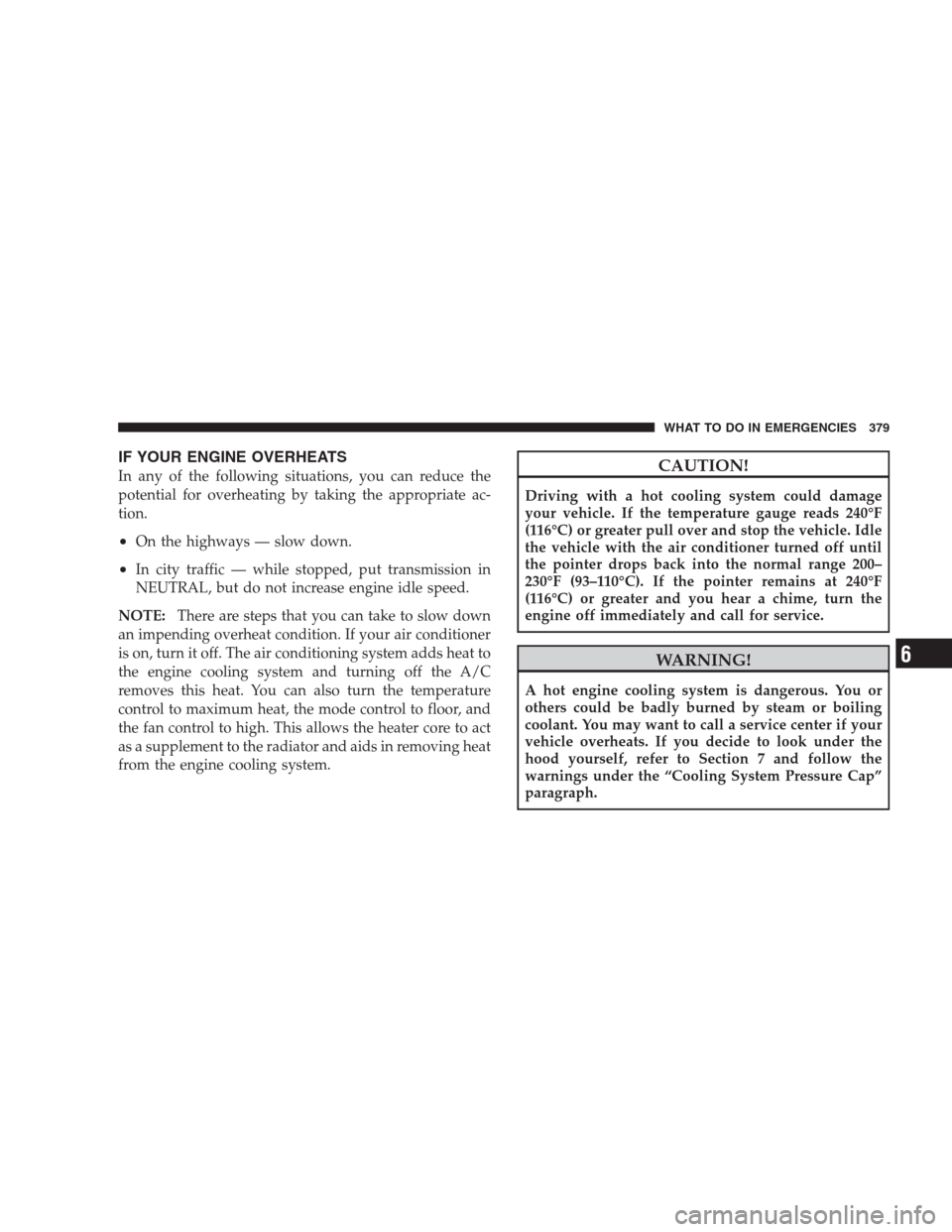
IF YOUR ENGINE OVERHEATS
In any of the following situations, you can reduce the
potential for overheating by taking the appropriate ac-
tion.
•On the highways — slow down.
•In city traffic — while stopped, put transmission in
NEUTRAL, but do not increase engine idle speed.
NOTE:There are steps that you can take to slow down
an impending overheat condition. If your air conditioner
is on, turn it off. The air conditioning system adds heat to
the engine cooling system and turning off the A/C
removes this heat. You can also turn the temperature
control to maximum heat, the mode control to floor, and
the fan control to high. This allows the heater core to act
as a supplement to the radiator and aids in removing heat
from the engine cooling system.
CAUTION!
Driving with a hot cooling system could damage
your vehicle. If the temperature gauge reads 240°F
(116°C) or greater pull over and stop the vehicle. Idle
the vehicle with the air conditioner turned off until
the pointer drops back into the normal range 200–
230°F (93–110°C). If the pointer remains at 240°F
(116°C) or greater and you hear a chime, turn the
engine off immediately and call for service.
WARNING!
A hot engine cooling system is dangerous. You or
others could be badly burned by steam or boiling
coolant. You may want to call a service center if your
vehicle overheats. If you decide to look under the
hood yourself, refer to Section 7 and follow the
warnings under the “Cooling System Pressure Cap”
paragraph.
WHAT TO DO IN EMERGENCIES 379
6
Page 413 of 493
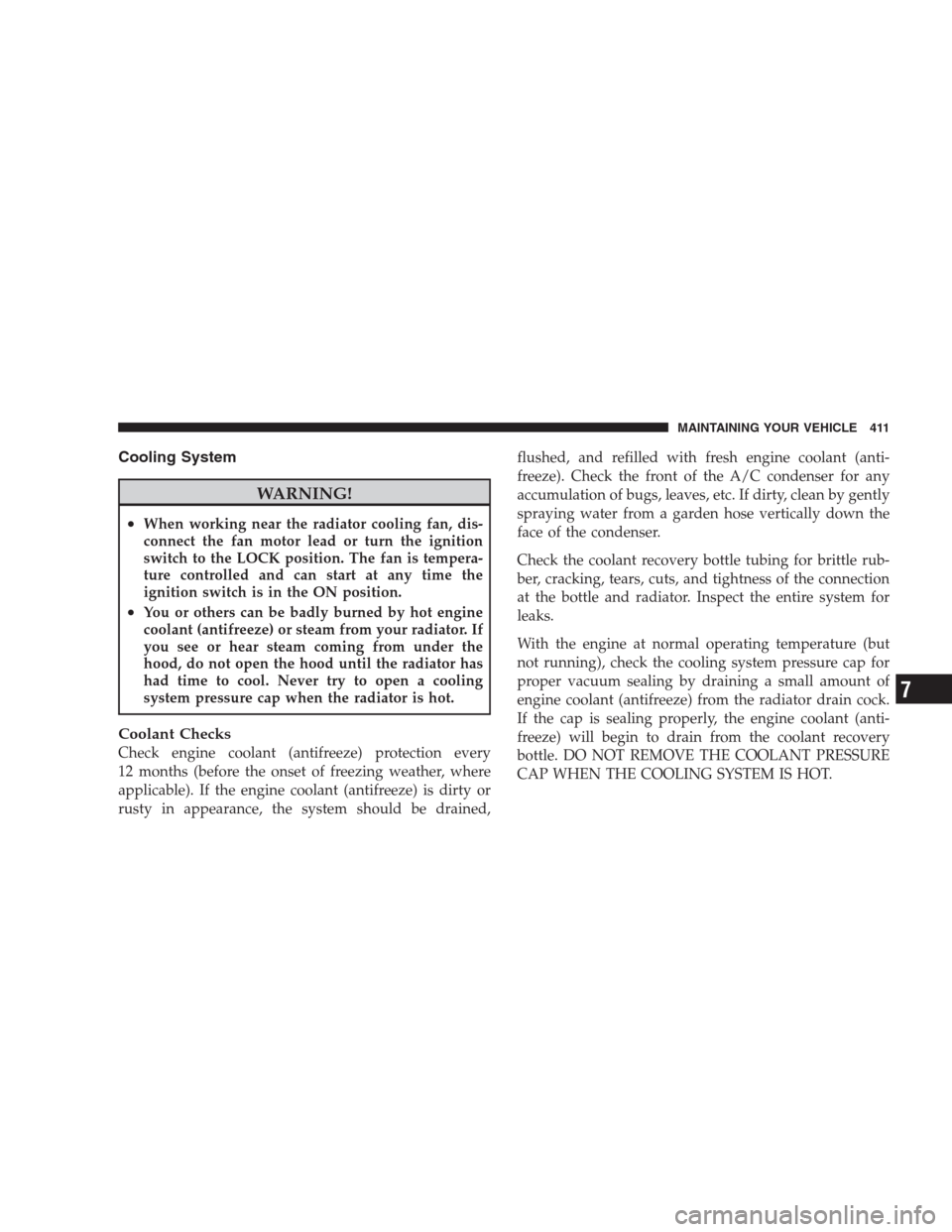
Cooling System
WARNING!
•When working near the radiator cooling fan, dis-
connect the fan motor lead or turn the ignition
switch to the LOCK position. The fan is tempera-
ture controlled and can start at any time the
ignition switch is in the ON position.
•You or others can be badly burned by hot engine
coolant (antifreeze) or steam from your radiator. If
you see or hear steam coming from under the
hood, do not open the hood until the radiator has
had time to cool. Never try to open a cooling
system pressure cap when the radiator is hot.
Coolant Checks
Check engine coolant (antifreeze) protection every
12 months (before the onset of freezing weather, where
applicable). If the engine coolant (antifreeze) is dirty or
rusty in appearance, the system should be drained,flushed, and refilled with fresh engine coolant (anti-
freeze). Check the front of the A/C condenser for any
accumulation of bugs, leaves, etc. If dirty, clean by gently
spraying water from a garden hose vertically down the
face of the condenser.
Check the coolant recovery bottle tubing for brittle rub-
ber, cracking, tears, cuts, and tightness of the connection
at the bottle and radiator. Inspect the entire system for
leaks.
With the engine at normal operating temperature (but
not running), check the cooling system pressure cap for
proper vacuum sealing by draining a small amount of
engine coolant (antifreeze) from the radiator drain cock.
If the cap is sealing properly, the engine coolant (anti-
freeze) will begin to drain from the coolant recovery
bottle. DO NOT REMOVE THE COOLANT PRESSURE
CAP WHEN THE COOLING SYSTEM IS HOT.
MAINTAINING YOUR VEHICLE 411
7
Page 416 of 493
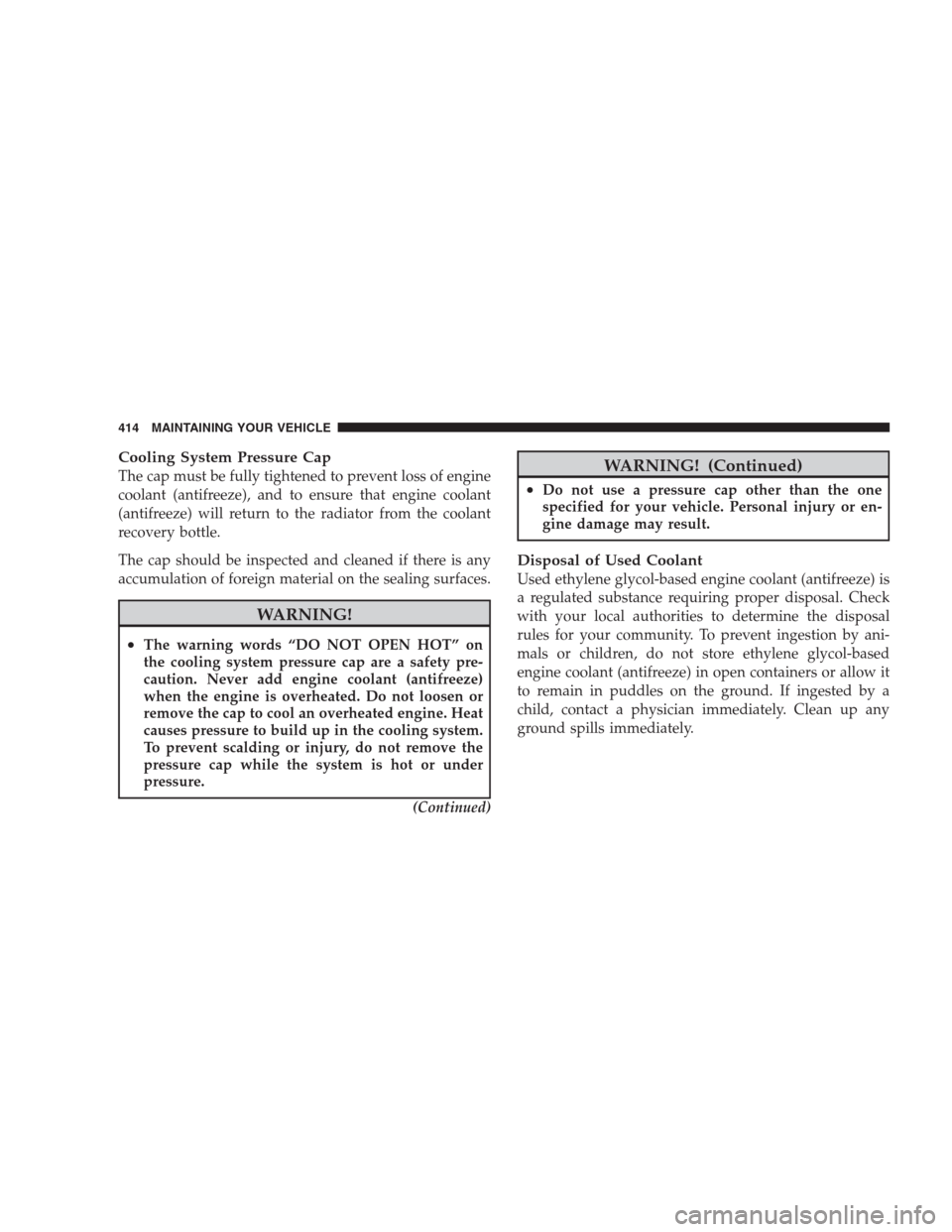
Cooling System Pressure Cap
The cap must be fully tightened to prevent loss of engine
coolant (antifreeze), and to ensure that engine coolant
(antifreeze) will return to the radiator from the coolant
recovery bottle.
The cap should be inspected and cleaned if there is any
accumulation of foreign material on the sealing surfaces.
WARNING!
•The warning words “DO NOT OPEN HOT” on
the cooling system pressure cap are a safety pre-
caution. Never add engine coolant (antifreeze)
when the engine is overheated. Do not loosen or
remove the cap to cool an overheated engine. Heat
causes pressure to build up in the cooling system.
To prevent scalding or injury, do not remove the
pressure cap while the system is hot or under
pressure.
(Continued)
WARNING! (Continued)
•Do not use a pressure cap other than the one
specified for your vehicle. Personal injury or en-
gine damage may result.
Disposal of Used Coolant
Used ethylene glycol-based engine coolant (antifreeze) is
a regulated substance requiring proper disposal. Check
with your local authorities to determine the disposal
rules for your community. To prevent ingestion by ani-
mals or children, do not store ethylene glycol-based
engine coolant (antifreeze) in open containers or allow it
to remain in puddles on the ground. If ingested by a
child, contact a physician immediately. Clean up any
ground spills immediately.
414 MAINTAINING YOUR VEHICLE
Page 417 of 493
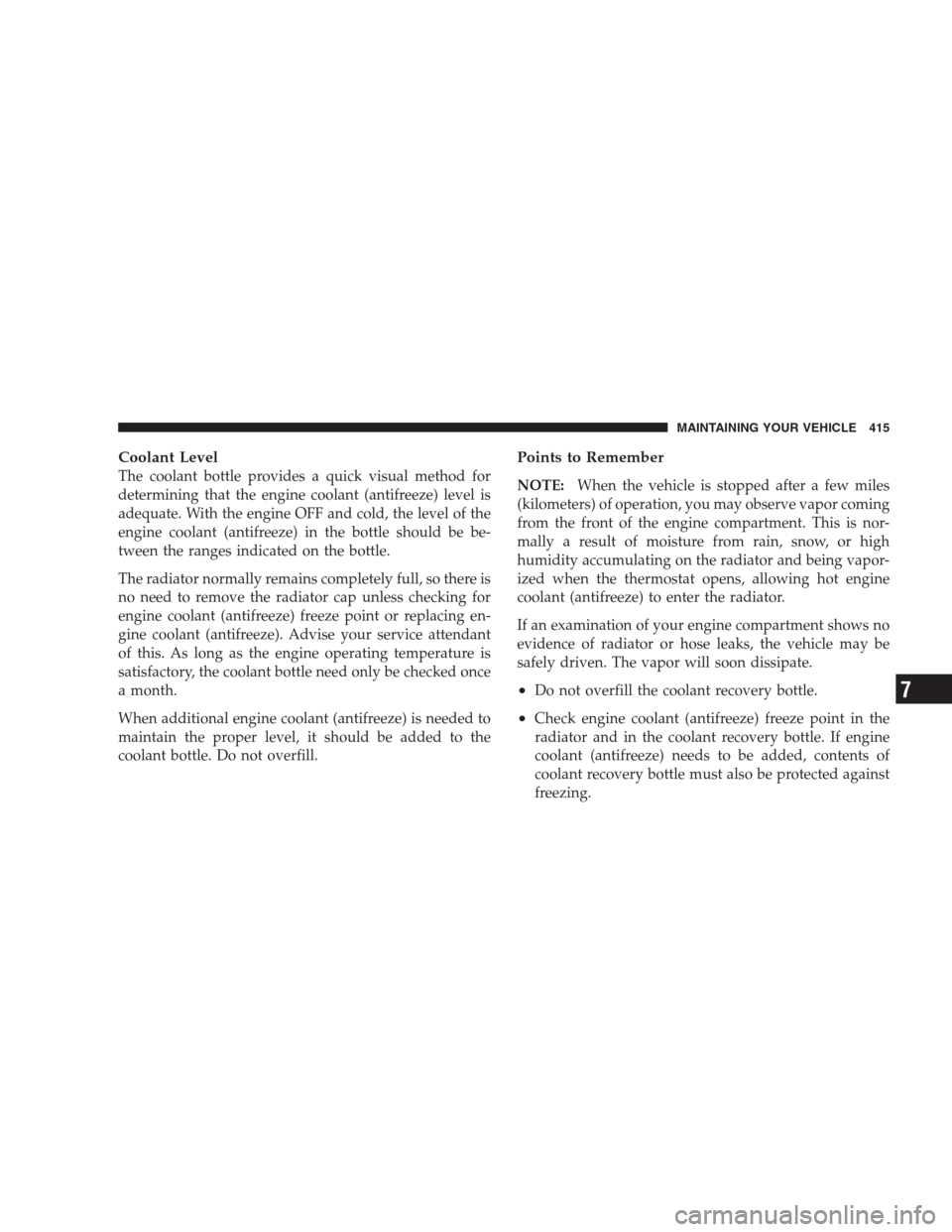
Coolant Level
The coolant bottle provides a quick visual method for
determining that the engine coolant (antifreeze) level is
adequate. With the engine OFF and cold, the level of the
engine coolant (antifreeze) in the bottle should be be-
tween the ranges indicated on the bottle.
The radiator normally remains completely full, so there is
no need to remove the radiator cap unless checking for
engine coolant (antifreeze) freeze point or replacing en-
gine coolant (antifreeze). Advise your service attendant
of this. As long as the engine operating temperature is
satisfactory, the coolant bottle need only be checked once
a month.
When additional engine coolant (antifreeze) is needed to
maintain the proper level, it should be added to the
coolant bottle. Do not overfill.
Points to Remember
NOTE:When the vehicle is stopped after a few miles
(kilometers) of operation, you may observe vapor coming
from the front of the engine compartment. This is nor-
mally a result of moisture from rain, snow, or high
humidity accumulating on the radiator and being vapor-
ized when the thermostat opens, allowing hot engine
coolant (antifreeze) to enter the radiator.
If an examination of your engine compartment shows no
evidence of radiator or hose leaks, the vehicle may be
safely driven. The vapor will soon dissipate.
•Do not overfill the coolant recovery bottle.
•Check engine coolant (antifreeze) freeze point in the
radiator and in the coolant recovery bottle. If engine
coolant (antifreeze) needs to be added, contents of
coolant recovery bottle must also be protected against
freezing.
MAINTAINING YOUR VEHICLE 415
7
Page 418 of 493
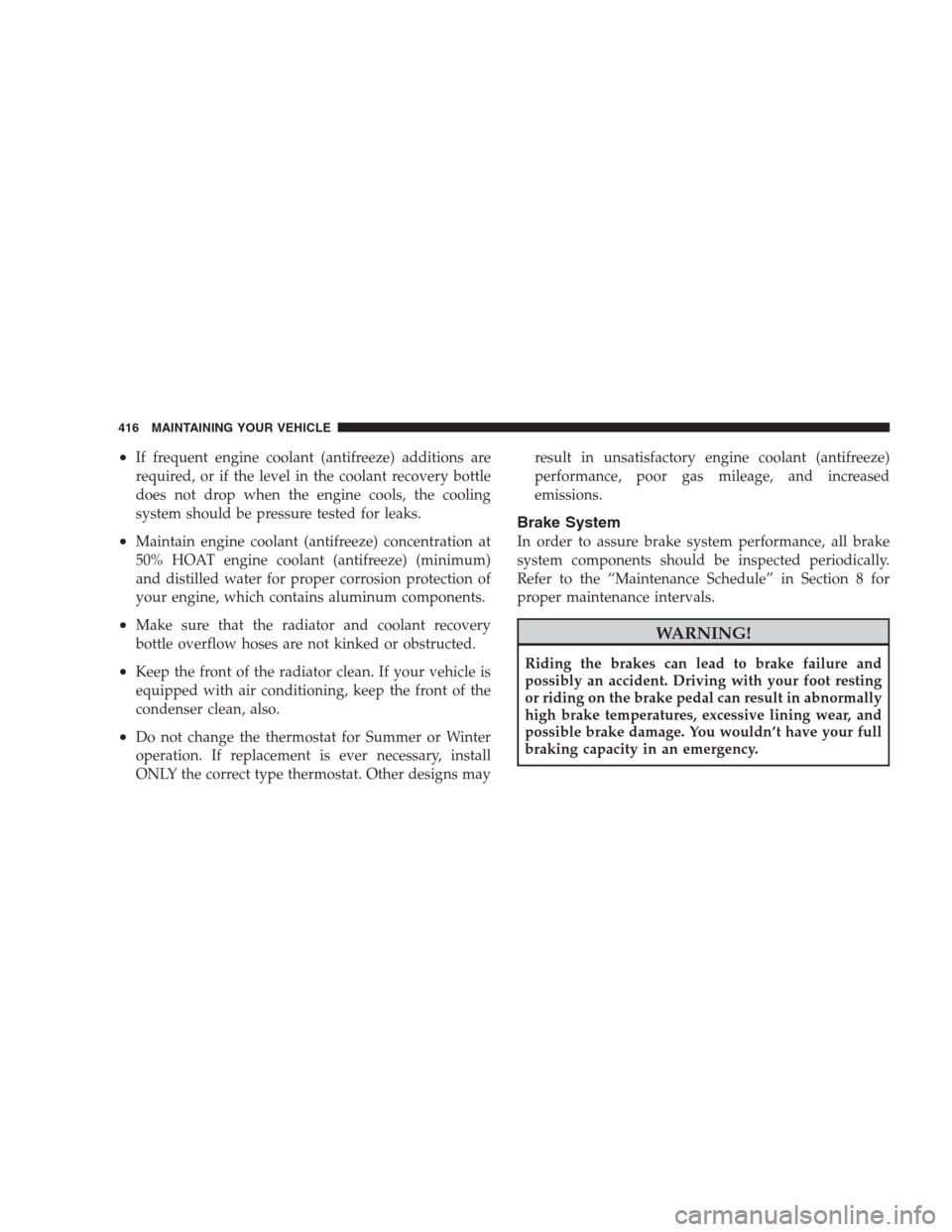
•If frequent engine coolant (antifreeze) additions are
required, or if the level in the coolant recovery bottle
does not drop when the engine cools, the cooling
system should be pressure tested for leaks.
•Maintain engine coolant (antifreeze) concentration at
50% HOAT engine coolant (antifreeze) (minimum)
and distilled water for proper corrosion protection of
your engine, which contains aluminum components.
•Make sure that the radiator and coolant recovery
bottle overflow hoses are not kinked or obstructed.
•Keep the front of the radiator clean. If your vehicle is
equipped with air conditioning, keep the front of the
condenser clean, also.
•Do not change the thermostat for Summer or Winter
operation. If replacement is ever necessary, install
ONLY the correct type thermostat. Other designs mayresult in unsatisfactory engine coolant (antifreeze)
performance, poor gas mileage, and increased
emissions.
Brake System
In order to assure brake system performance, all brake
system components should be inspected periodically.
Refer to the “Maintenance Schedule” in Section 8 for
proper maintenance intervals.
WARNING!
Riding the brakes can lead to brake failure and
possibly an accident. Driving with your foot resting
or riding on the brake pedal can result in abnormally
high brake temperatures, excessive lining wear, and
possible brake damage. You wouldn’t have your full
braking capacity in an emergency.
416 MAINTAINING YOUR VEHICLE
Page 474 of 493
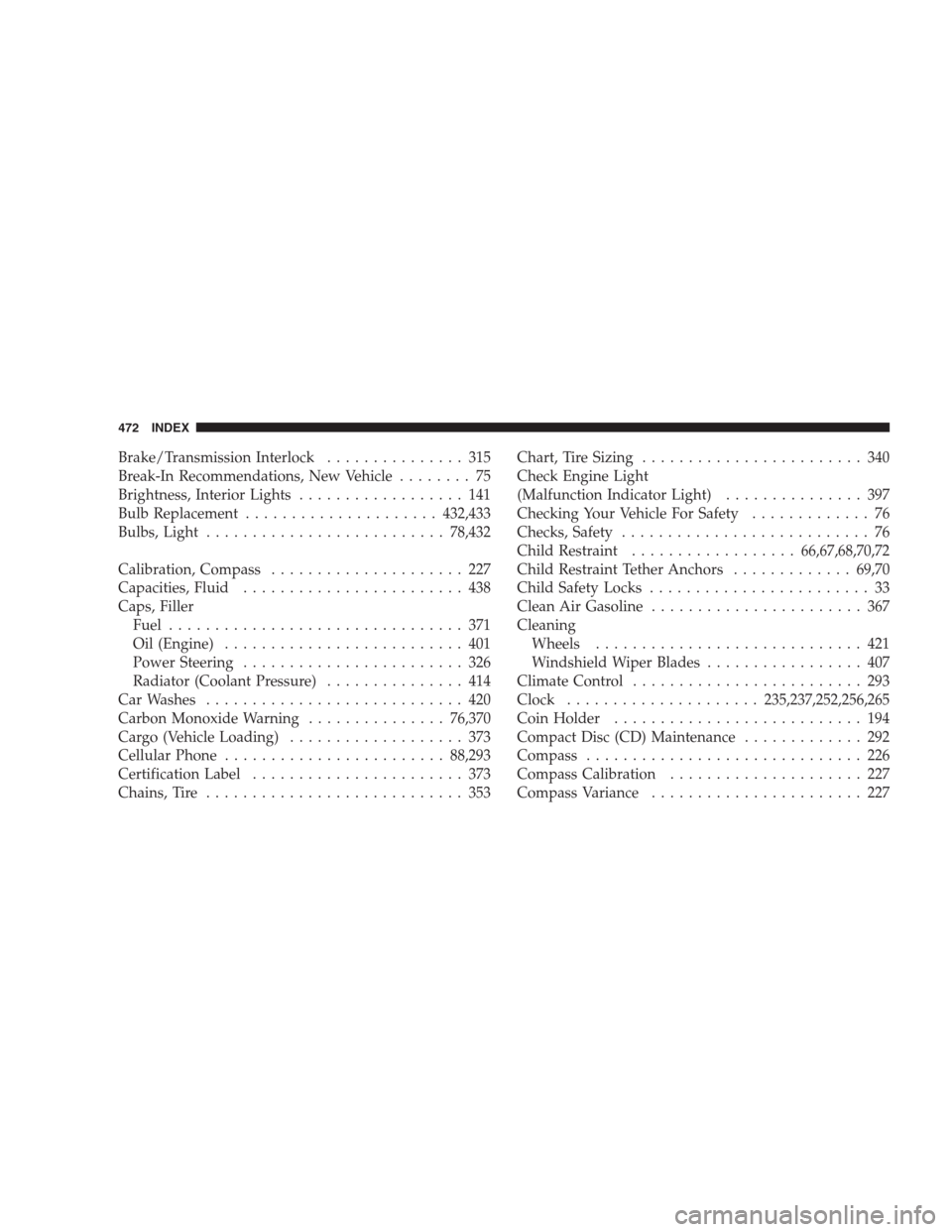
Brake/Transmission Interlock............... 315
Break-In Recommendations, New Vehicle........ 75
Brightness, Interior Lights.................. 141
Bulb Replacement.....................432,433
Bulbs, Light..........................78,432
Calibration, Compass..................... 227
Capacities, Fluid........................ 438
Caps, Filler
Fuel................................ 371
Oil (Engine).......................... 401
Power Steering........................ 326
Radiator (Coolant Pressure)............... 414
Car Washes............................ 420
Carbon Monoxide Warning...............76,370
Cargo (Vehicle Loading)................... 373
Cellular Phone........................88,293
Certification Label....................... 373
Chains, Tire............................ 353Chart, Tire Sizing........................ 340
Check Engine Light
(Malfunction Indicator Light)............... 397
Checking Your Vehicle For Safety............. 76
Checks, Safety........................... 76
Child Restraint..................66,67,68,70,72
Child Restraint Tether Anchors.............69,70
Child Safety Locks........................ 33
Clean Air Gasoline....................... 367
Cleaning
Wheels............................. 421
Windshield Wiper Blades................. 407
Climate Control......................... 293
Clock.....................235,237,252,256,265
Coin Holder........................... 194
Compact Disc (CD) Maintenance............. 292
Compass.............................. 226
Compass Calibration..................... 227
Compass Variance....................... 227
472 INDEX
Page 475 of 493
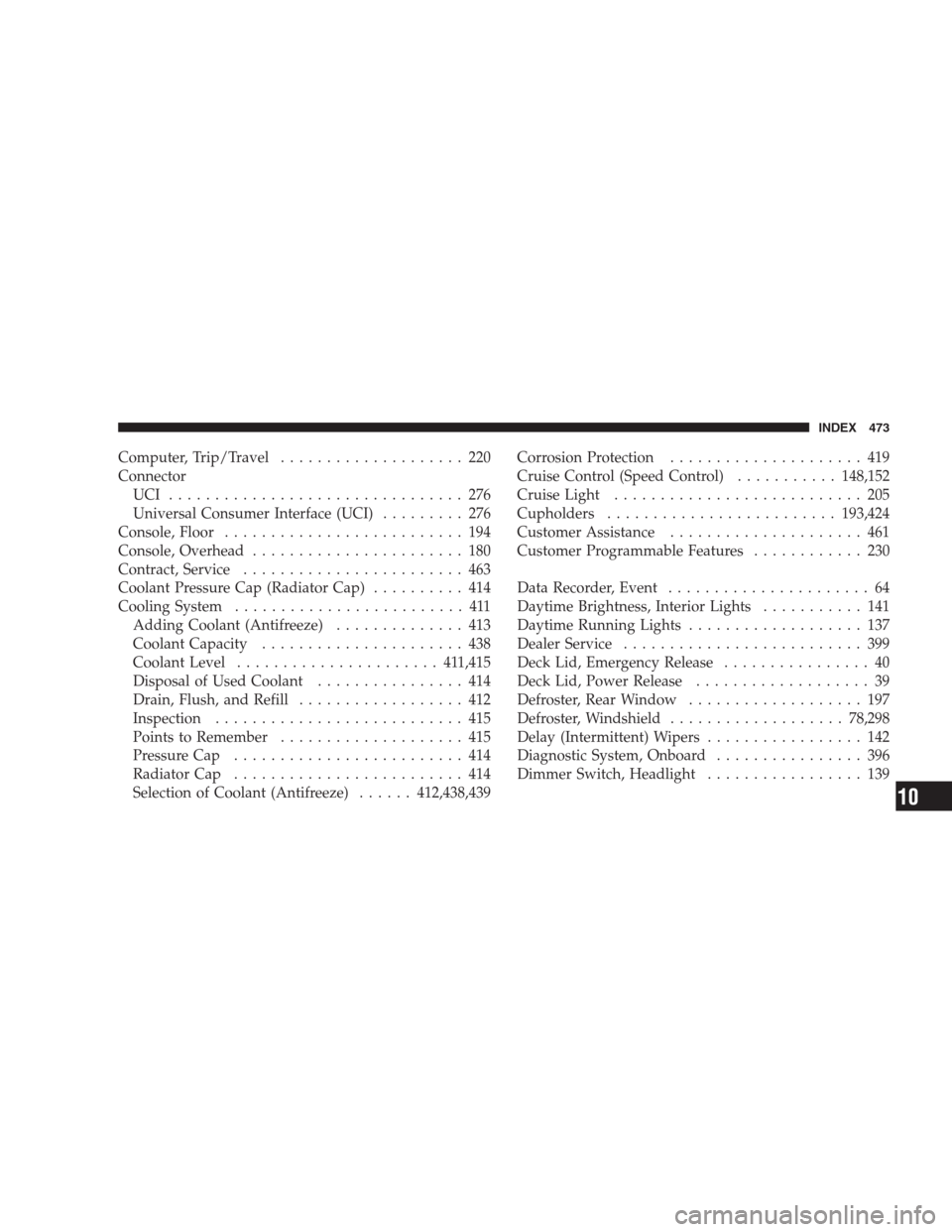
Computer, Trip/Travel.................... 220
Connector
UCI ................................ 276
Universal Consumer Interface (UCI)......... 276
Console, Floor.......................... 194
Console, Overhead....................... 180
Contract, Service........................ 463
Coolant Pressure Cap (Radiator Cap).......... 414
Cooling System......................... 411
Adding Coolant (Antifreeze).............. 413
Coolant Capacity...................... 438
Coolant Level...................... 411,415
Disposal of Used Coolant................ 414
Drain, Flush, and Refill.................. 412
Inspection........................... 415
Points to Remember.................... 415
Pressure Cap......................... 414
Radiator Cap......................... 414
Selection of Coolant (Antifreeze)......412,438,439Corrosion Protection..................... 419
Cruise Control (Speed Control)...........148,152
Cruise Light........................... 205
Cupholders.........................193,424
Customer Assistance..................... 461
Customer Programmable Features............ 230
Data Recorder, Event...................... 64
Daytime Brightness, Interior Lights........... 141
Daytime Running Lights................... 137
Dealer Service.......................... 399
Deck Lid, Emergency Release................ 40
Deck Lid, Power Release................... 39
Defroster, Rear Window................... 197
Defroster, Windshield...................78,298
Delay (Intermittent) Wipers................. 142
Diagnostic System, Onboard................ 396
Dimmer Switch, Headlight................. 139
INDEX 473
10
Page 485 of 493

Programming Transmitters
(Remote Keyless Entry).................... 20
Radial Ply Tires......................... 350
Radiator Cap (Coolant Pressure Cap).......... 414
Radio Operation........................ 293
Radio Remote Controls.................... 291
Radio, Satellite.......................281,287
Rain Sensitive Wiper System................ 144
Rear Cupholder......................... 193
Rear Park Sense System................... 175
Rear Seat, Folding....................... 127
Rear Window Defroster................... 197
Rear Window Features.................... 197
Reclining Front Seats..................... 123
Recorder, Event Data...................... 64
Recreational Towing...................... 375
Reformulated Gasoline.................... 367
Refrigerant............................ 406Release, Hood.......................... 132
Reminder, Lights On..................... 137
Reminder, Seat Belt....................... 49
Remote Control
Starting System........................ 25
Remote Keyless Entry (RKE)................. 20
Remote Sound System (Radio) Controls........ 291
Remote Starting System.................... 25
Remote Trunk Release..................... 39
Replacement Bulbs....................... 432
Replacement Keys........................ 16
Replacement Parts....................... 399
Replacement Tires....................... 352
Reporting Safety Defects................... 464
Restraint, Head......................... 125
Restraints, Child......................... 66
Restraints, Occupant...................... 41
Rocking Vehicle When Stuck................ 389
Rotation, Tires.......................... 355
INDEX 483
10